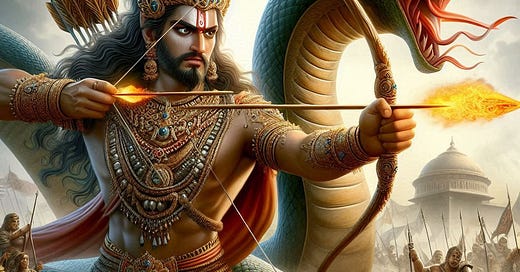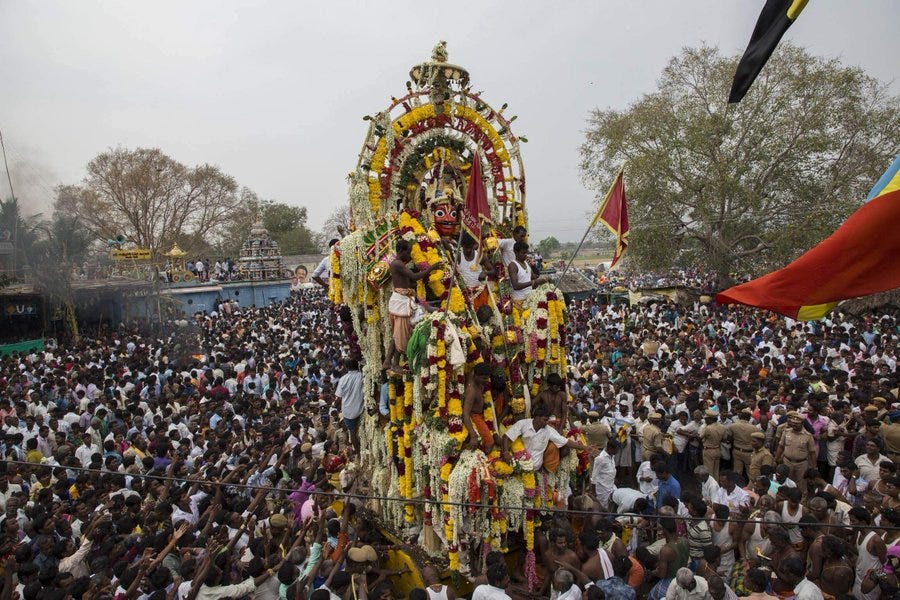The Mahabharatha is a text that is prevalent across our country. But, you will find slightly different tales in different parts and some stories are even added entirely or changed so much that they significantly deviate from Vyasa Bharatha. The story of Iravan or Aravaan as he is known down south is one such. Aravaan or Iravan was the son of Ulupi and Arjuna, a powerful Naga warrior, well versed in magic.
The lore followed in South India, esp Tamil Nadu, is that the Pandavas and Kauravas had to sacrifice a man to assure victory in the war (in Vyasa Bharata, there is neither such a requirement nor any human sacrifice at any other time).
There were only 3 ppl who qualifed for sacrifice because they had all the qualities required - Arjuna, Krishna and Iravan. Iravan offered himself selflessly. Krishna asked him if he had any wishes and he said that he wished to experience married life.
Since Iravan was going to be sacrificed the next morning no one would wed their daughter to him. So Krishna himself turned into Mohini and married Iravan. The next day Mohini became a widow as Iravan cut off all his limbs before finally offering his head himself to Goddess Kali.
There are slightly different versions of the same story too. In one, Iravan asks for two boons of Krishna. One is his marriage, which Krishna fulfills as Mohini. The other boon is that Iravan should be able to contribute to the Dharma yuddha. So Krishna gives him his chance on Day 8, when he fights a glorious battle before attaining the warrior’s death upon the battlefield.
A third version of the story is also very interesting. Krishna marries Iravan to a girl, Annaraki, whose horoscope indicates that she would be a bride for just one day.
In this version, Iravan also asks for the boon that when he cuts away his limbs, instead of the stench of blood, fragrance must fill the environs. Also, that when his head is cut off from his body in Day 8 of battle, it must roll back to the temple where he sacrificed himself and remain there, facing the battlefield with his eyes filled with eternal life to witness Mother Draupadi wash her tresses with the blood of Dushasana (another story that is NOT part of Vyasa MB).
This Iravan/ Aravaan is usually found in Draupadi Amman temples. His eyes are always wide open, witnessing the Kurukshetra war, as per his boon. His head faces Kurukshetra too. A side story goes on abt how Duryodhan tried to sacrifice Iravan for HIS victory on Amavasya but Krishna pipped him by getting Surya- Chandra together the previous day thus 'creating' Amavasya and clearing the way for the Pandavas to sacrifice Iravan.
Iravaan/ Aravaan’s great sacrifice is marked by the transgender community in the Koovagam Kothandavar temple in TN with an 18 day festival in Apr/ May. The presiding deity is, of course, Iravan or Aravaan or Nallaravar as he is called here. The transgender community weds Iravan symbolically, dressed in bridal finery. Then the next day when the deity is ‘sacrificed’, they go thru the rituals of widowhood and mourn his death like widows do. From the name Aravaan comes the term Aravaani, which is a term used for transgender folk in TamilNadu.
At the beginning of the Koothandavar festival, flags are erected in the temple to signify the beginning of the war with Aravaan supreme sacrifice. At the end of 18th day, they are taken in procession along with Aravan's 'head' accompanied by crowds of his 'brides' mourning and wailing. Do note that NONE of this happens in Vyasa MB where Iravan battles from Day 1, dies after a glorious magical battle on Day 8.
My first published story ‘The Fall of the First Son’ was on Iravan, in the anthology “Unsung Valour”. Link: https://www.amazon.in/Unsung-Valour-Forgotten-Warriors-Kurukshetra/dp/9390358353
Pics: Kothandavar festival, Koovagam
Credit: https://www.newindianexpress.com/galleries/nation/2018/May/02/villupurams-koovagam-festival-in-pictures-a-celebration-of-transgender-identity-101474.html
Pic credit: https://upload.wikimedia.org/wikipedia/commons/d/d2/Aravan_head.jpg
This is all you will generally find of Koothandavar. I believe the rest of his body is made out of straw and then the cutting of limbs depicted using them before the head alone is carried in procession.







Wow… mahabharata is usually told to be an oppressive ‘aryan’ text by some political groups, yet it has such deep connection to Tamil Nadu and its culture